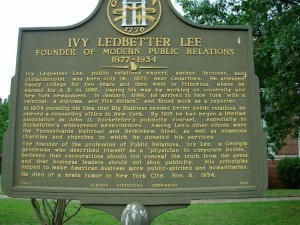
Public Relations has deep roots in the Deep South.
Not many people remember the Georgia native who helped give birth to the modern era of PR. And many of the people who do remember the legend of Ivy Ledbetter Lee prefer not to talk about him.
I’ll break that silence today.
Hopefully Lee’s career will provide lessons that are still relevant today.
I need to immediately address some of the baggage that Lee carries. The first is that after a long career as the best in his field, Lee died in disgrace.
We know for certain that Lee represented I.G. Farben Industrie of Germany in the early 1930s. He was accused of being anti-Semitic and conducting propaganda for the Nazi government.
Lee died in 1934 while under subpoena to testify before Congress. He never had a chance to respond, much less clear his name.
The lesson here may be to choose your clients wisely. Negative associations often lead to negative perceptions, true or not.
I don’t have any evidence to defend Lee and won’t bother to try.
The second weight on Lee’s reputation today is determining his role in the birth of PR.
Many scholars consider Lee to be the first full-time public relations practitioner, while others say Edward Bernays was more influential in founding the profession and had a much longer career. It’s not a clear-cut argument on either side. Plus, Bernays spent the second half of his career promoting himself as “America’s No. 1 publicist.”
Even scholars who award Bernays the “founding father of PR” title, acknowledge that Lee issued the first news release.
I can’t resolve here the conflict of who is more important to the industry. It’s fair to say that both men played important early roles. I’m focused on Lee solely because of his connection to Atlanta, where I practice public relations.
That’s a lot of baggage, to be certain. But once you get past that, you find an interesting guy, with deep Atlanta connections.
Lee counted among his friends famous writers and editors from the Atlanta Constitution newsroom. These friendships included Henry W. Grady, Frank L. Stanton, Clark Howell, Evan Howell, Samuel Small and Wallace P. Reed.
Lee published a book in 1909 titled, “‘Uncle Remus,’ Joel Chandler Harris as Seen by a Few of His Friends.”
Lee wrote the introduction and compiled a collection of letters and speeches about Harris. The book includes the eulogy for his friend.
Like many people who find their way into PR, Lee started as a reporter. While studying at Princeton, Lee wrote for several New York newspapers, including the New York Times.
On Wednesday, I’ll explore Lee’s public relations career and his legacy.
The following sources were helpful in writing this history of Ivy Ledbetter Lee: